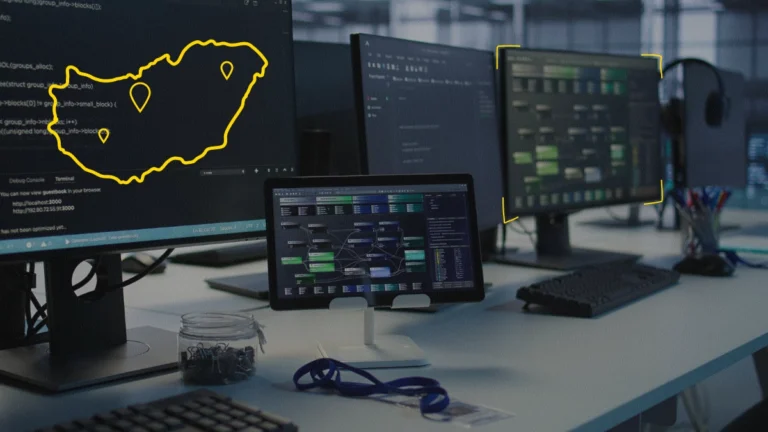Global Onboarding for Distributed Tech Teams: Challenges and Best Practices for Effective Integration
- What Is Global Onboarding?
- Why Well-Structured Onboarding Is Crucial for Distributed Tech Teams
- Key Challenges in Global Onboarding and How to Overcome Them
- Essential Stages of the Global Onboarding Process
- Best Practices for Onboarding International Employees From Mobilunity
- Measuring Onboarding Success
- To Conclude
As a dedicated development team (DDT) provider, we know that hiring offshore developers is no longer just a trend – it’s already a strategic norm for businesses looking to scale quickly.
Being slow in the tech industry often equals losing, so organizations need to make their off-site experts engaged and productive ASAP. That’s why effective onboarding is vital.

Check why distributed tech teams need a structured onboarding process and learn this process’s key stages, challenges, and best practices.
What Is Global Onboarding?
Global onboarding is helping new tech team members from distant locations integrate into a company’s environment and workflows. This process aims at equipping developers with the knowledge and resources to become effective, engaged, and connected.
The global orientation and adaptation process differs from the local one because it considers cultural differences, local regulations, and time zone constraints. With a standardized onboarding process, companies ensure that new hires integrate into the organization in the minimal time.
Why Well-Structured Onboarding Is Crucial for Distributed Tech Teams
With unsystematic developers onboarding, your team members will start bringing business value in 3-6 months, on average. Such an approach won’t help you make these experts an asset soon.
A structured global onboarding program improves:
- Your developers’ engagement and performance. Clear processes minimize the time to reach full productivity and boost involvement.
- Retention rate. Engineers are more likely to stay loyal to your organization when feeling supported and valued from the start.
- Alignment with your company culture. Proper orientation allows devs to understand and share your corporate values and goals.
- Team cohesion. Mutual trust, respect, shared objectives, and a sense of belonging encourage team members to give their best effort.
A well-defined employee integration plan is crucial when hiring dedicated tech teams, as it helps you achieve all the mentioned benefits.
Key Challenges in Global Onboarding and How to Overcome Them
Onboarding remote software developers should be arranged in a way to help your new hires adapt while addressing the challenges typical for distributed teams:
| Challenge | Description | Solution |
| Limited Control Over Your Developers | The first concern is that without focused oversight, remote workers may show reduced accountability and consistency during onboarding and after it. This can result in their lower productivity and extended deadlines. | Using collaborative tools, running regular check-ins, fostering transparent communication, and setting outcome-focused KPIs will allow you to achieve better team alignment and visibility from day one. |
| Cultural Variations | Differences in communication styles, work attitudes, and decision-making approaches may cause misunderstandings and inefficiencies within your team even during the onboarding period. | Cultural diversity can be effectively addressed by fostering respect and cultural sensitivity from the first days of onboarding through encouraging transparency and promoting inclusion. |
| Time Zone Differences | Poorly overlapping business hours can result in feedback delays, missed context, fragmented communication, and other onboarding іnefficiency. | Businesses can align working schedules with off-site tech experts and use asynchronous communication to ensure a smooth, timely start of remote team members. These include PM tools, documentation platforms, messengers, video recording solutions, etc. |
| Poor Team Cohesion | Without social integration, developers can feel unsupported, disconnected, and unsure of what they are expected to do next. This leads to slower engagement and poor trust within a team. | Promoting introductions, mentorship, team activities, transparency, and respect will help developers feel part of the culture and get aligned from the very start. |
| Remote IT Infrastructure Setup | Failing to provide timely access to code repositories, development environments, cloud tools, or VPNs will prevent developers from contributing early. | Preparing standardized onboarding checklists in compliance with company policies, alongside ongoing support of remote processes, is the key to your developers’ high productivity from the first days. |
A clearly outlined employee integration strategy often includes solutions to these management challenges, setting the foundation for the smooth integration of newcomers. It encourages them to feel valued and aligned from the start.
Essential Stages of the Global Onboarding Process
Onboarding software developers is successful once it includes clearly defined phases, terms, and expectations. The following stages are necessary for helping your hires feel aligned with your organization’s workflows, culture, and goals.
- Pre-Boarding: You need to prepare the equipment and software, set up an email account, and provide access to the tools before the dev’s first working day. This phase also includes collecting documentation and signing contracts, becoming the ground for a new hire’s quick and efficient start.
- First Week: The first several days of orientation will be full of welcoming meetings, team introductions, and training programs. That’s when team leads share their company mission, values, and goals and facilitate the social integration of new developers into the company culture.
- First 1-3 Months: The importance of this phase lies in tracking the employee’s progress while ensuring support, encouraging open dialogue during the feedback sessions. This period allows programmers to fit their roles and responsibilities, remaining engaged and productive.
These are the standard, high-level steps of successful global talent onboarding. And now, let’s get into the details and explore how Mobilunity approaches this process.
Best Practices for Onboarding International Employees From Mobilunity
After onboarding over 1,000 tech experts across North America, Western Europe, Asia, and beyond, we’ve learned what really matters during onboarding — and what’s just noise. Our process isn’t about ticking boxes — it’s about making sure both client and developer hit the ground running with minimal friction.
“Onboarding is one of the most sensitive stages in a consultant’s journey — even senior-level professionals might stumble if it’s poorly handled,” says Yulia Borysenko, Staff Services Director in Mobilunity.
Here’s how we do it — step by step.
1. Create a Clear Onboarding Plan
From our experience, the best onboarding plans are designed for the first three months. The onboarding plan isn’t a formality. It’s a roadmap. And it has to come from the client side, because only they know the business goals, project pace, and how they want this person to integrate.
“Being a senior doesn’t mean knowing what to do from day one. The context is new. The team is new. The rules are new. Even the quiet ones need structure — or they silently stall.”
We always encourage clients to define milestones for Week 1, Month 1, and the end of probation. Who’s guiding the newcomer? What are the expectations? What’s considered success? If that’s not clear, newcomers waste time guessing, and clients lose momentum without even realizing it.
That said, we also coach newcomers with a focused list of key questions to the client. These cover expectations, ways of working, team setup, and other strategic things that are better clarified early on.
2. Give Access to Everything Before Day One
Before the start date, the newcomer should already have access to all critical tools and platforms — email, VPN, project boards, documentation, etc.
“No one should start with: ‘Where’s my access?’ — Yulia notes. “We had cases when newcomers showed up, and nobody from the client side reached out. No access, no Slack hello. Imagine how it feels to start a new job like that.”
That’s why we share a clear, no-fluff onboarding guide: working hours, public holidays, types of absence, and all relevant internal policies. If the client has specifics (e.g., extra security steps or custom processes), we include that too.
Timezone differences, local work culture, and attitudes to work-life balance — all of that gets factored in from day one.
3. Set Expectations — Realistic Ones
Allow your developer time to adapt, as the “first days are all about detective work — digging through systems, reviewing documentation, and learning the ropes,” Yulia says.
Expecting meaningful output within the first few days is unrealistic. Instead, the goal is to let the person orient themselves, so that by week 2 or 3, they’re ready to contribute, not just observe.
We always remind our clients: it’s better to invest in the setup now than fix the detachment later. Burnout, disconnection, or disengagement often start with onboarding missteps.
4. Assign a Real Mentor — Not Just a Buddy
A mentor is someone who gives context, unblocks confusion, and helps avoid hidden pitfalls.
“A good mentor is like Google Maps for the first few weeks. Without it, people might still arrive — just 2x slower and more frustrated,” says Yulia.
The mentor doesn’t have to be a full-time trainer. It can be a team lead, a fellow developer, or someone who’s been on the project for a while. What matters is that they’re available, competent, and not treating this as “extra” work.
5. Ask for Feedback Early — and Use It
Don’t wait for the trial period to end to find out something’s wrong. We run 1:1 syncs after 1 week, 2 weeks, and then monthly during the trial. Why? Because silence doesn’t mean success.
“Some newcomers won’t say a word — they’ll just quietly detach. If we don’t ask the right questions early, we risk losing them before they even start performing.”
We use these check-ins to dig into blockers, misalignments, missing context, or hidden frustrations. And then — we fix them fast.
This onboarding process wasn’t built overnight. It’s based on a ton of trial and error, deep feedback from both engineers and clients, and our own internal learnings.
“What works is simple: transparency, structure, and timely support. The rest is just packaging,” Yulia concludes.
Measuring Onboarding Success
A strong and optimized onboarding program is the cornerstone for your developers’ productivity and retention. It’s an investment in your company, so measuring onboarding effectiveness is vital. Below are the two approaches that can help.
Performance Metrics
Below are the top five indicators that highlight the success of your employee integration efforts.
Employee Retention Rate: Tracks how many newly-hired developers stay with the company after onboarding or during their first 6-12 months, indicating their satisfaction and loyalty. For example, 93% of developers hired with Mobilunity successfully pass the probation period.
Time-to-Productivity: Measures how long it took the new global team members to consistently meet KPIs or reach performance benchmarks, showing the effectiveness of training and support.
Employee Satisfaction Scores: Show how new hires assess their onboarding experience. You can get these scores from surveys or feedback sessions.
Engagement Levels: Track new devs’ participation in the company’s activities, including attendance of training sessions, responding to surveys, joining team events, and more.
By analyzing these parameters, companies can identify strengths and address weaknesses in their onboarding efforts, continuously improving this process.
Employee and Client Surveys
In parallel with check-ins with developers, we send questionnaires to clients. Typically, we’ll ask you to share your first impressions two weeks after the start, so we know if there are any cultural or communication issues or language barriers early.
We’d like you to also state if the developer has completed the first tasks and their expertise has matched expectations.
However, you don’t need to wait for the questionnaire — if you notice any issue, speak up about it right away. Then, we can quickly fix problems rather than learning about them when it’s too late.
Additionally, you’ll have biweekly or monthly calls with Account Managers, where they can also share concerns.
Use Cases of Our Global Onboarding Program
As an IT staffing vendor and DDT provider, Mobilunity not only assists companies in finding, vetting with our technical interview service, and hiring their perfect-match tech talent. We also help with onboarding new developers for clients from diverse locations.
For example, ICUC, a Canadian social media management agency, reached out to us to extend their global development team. They believed that uniting skilled tech experts from around the globe would foster innovation.
Within a few weeks, we hired a dedicated dev team in Ukraine, which had a significant time difference with Canada. The company runs daily stand-ups at 10 am Montreal time (5 pm Kyiv time), supporting the 24/7 development cycle they strived for.
Additionally, each engineer received a personalized development roadmap, which proved the long-term intentions of both parties. As a result of our effective global onboarding and retention efforts, the churn rate of ICUC’s team was 2.9%, which was 5 times lower than the average churn rate in Canada (16%, as reported by LinkedIn). Learn more details in the ICUC case study.
Another example is our cooperation with XPLG, a leading provider of data analysis tools based in Israel. Within a couple of weeks, we extended their tech team with Ukraine-based front-end developers and QA engineers.
One of the driving forces of the effective onboarding was that hired devs visited XPLG’s office, and all the distributed team members agreed to communicate directly and respond promptly. Read how this approach boosted the team’s efficiency in the XPLG case study.
To Conclude
Companies must continuously refine their onboarding programs for global tech teams and adapt them to client, project, culture, and other specifics.
However, once you decide to hire offshore/nearshore tech talent with a reliable DDT provider, you can delegate most of these efforts. Leveraging their time-proven approaches to onboarding distributed tech teams, you can count on your engineers’ high performance, engagement, and loyalty.














CLIENT FEEDBACK
“Mobilunity continuously delivered high-quality, exceptionally talented people and resources for us. We expect to continue and develop our work with Mobilunity in the near future.”
Haim Koschitzky, CEO at XPLG